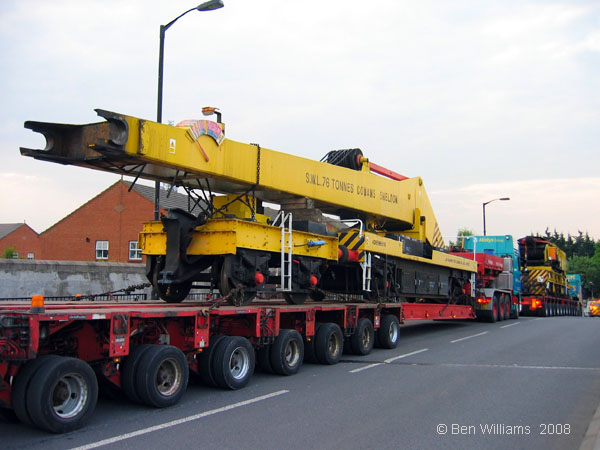
Historical Background
Strut Jib superseded by Telescopic Jib
Mobile crane technology was to mix with railway crane technology in six new, telescopic jib, 75-tonne breakdown cranes, the last breakdown cranes to be built for Britain’s railways. For decades breakdown cranes had simply evolved, however for these new cranes British Railways took a completely fresh approach and came up with some pioneering features…
BR placed its last order for new breakdown cranes on Cowans Sheldon, for six diesel-hydraulic 75-tonne cranes with telescopic jib. These were built in 1977 but didn’t enter full service until 1980 due to difficulties in finalising hydraulic operation of the outriggers.
In the early 1970s, a review of breakdown and recovery operations, and other operations such as bridgework for which large capacity cranes may be required, had identified the need for a total of 18 diesel powered cranes of 75 tonne capacity. However two already existed (the two diesel-mechanical cranes on the Southern Region) and a further ten could be converted from steam, leaving a deficiency of just six to be answered with new build.
Conversion of the existing 75-ton strut jib steam cranes to diesel-hydraulic broadly coincided with the order for the new telescopic-jib cranes and formed part of the same overall programme, as did the conversion of five 45-ton steam cranes in the mid-1980s. Thus, whilst the telescopic-jib crane superseded the strut jib crane in design terms, the latter was expected to continue in use for a long time to come.
In fact two of the strut jib 75 tonners, ADRC96702 and ADRC96709, were in operation with Network Rail as late as 2006. They were withdrawn consequent to the derailment of ADRC96702's jib runner in the November of that year, the cause of which was found to be uneven wheel loading due to an undetected twist in the frame. ADRC96702 was scrapped in 2008 but four other 75-tonners, including ADRC96709, have been preserved.

ADRC96702 departs Old Oak Common for the Ron Hull breaker's yard on 22.5.2008. The law requires abnormal loads to be divided if possible; division here was by gas-axe.
By 1977 there had been many technological advances in mobile crane design, mainly originating from the vast increase in the size and capabilities of road-mobile cranes, and some of this technology now crossed over into railway breakdown cranes with this new British Railways design. The six cranes built in 1977 thus became the first heavy railway breakdown cranes in the country whose design was not directly derived from the GWR’s seminal 36-ton crane of 1908.
Unfortunately the six 75-tonne telescopic jib cranes proved to be very troublesome upon introduction and had to be returned to the maker a number of times before being considered acceptable. Although some remain in service to this day, the first telescopic jib crane was scrapped as early as 2000 or 2001, being outlived by several of the earlier 75-ton strut jib conversions.
Notwithstanding the introduction of six new cranes into the home railway system, the overall programme was for a phased reduction in breakdown crane numbers, twenty-five cranes being envisaged at the time as sufficient to meet the requirements of the 1980s and beyond. This total was to come under review in 1982 and the numbers in service gradually decreased from 35 in that year to 22 in 1989 and to as few as 3 in 2008.
One of the reasons given in 1980 for the forthcoming reduction in the number of cranes was the dramatic decline in derailments; another was the increasing use of hydraulic jacking equipment for re-railing. The following section, entitled "The Demise of the Railway Breakdown Crane," examines the change in circumstances in greater detail.
There is more about the telescopic jib cranes in the "Design and Development section".